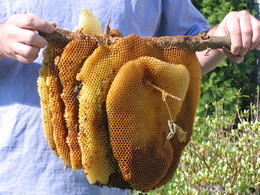Cost of package, 175 Sale of Product value. 60 lbs. at 5 gallons or 20 quarts at 20.00 each. 400 income
Other factors (hive bodies and such NOT included. This assumes the gifting of a few hundred dollars of hardware.
Time. Say 1.5 hours a week x 6 months NINE to TEN hours per hive. @ 10.00 hr. 100.00Cost of Oxalic Acid treatment per hives. 5.00
Cost of 20 quarts and lids. 1.00 each 20.00. Cost extracting/cleanup and labor to fill the jars 20.00 and then trying to sell them. More labor.
Depreciation of frames and foundation. 20 (cost 3.00 each.) Make it 1.00 per year.
20.00 more taken out.
400 Incomed. less
175.00 Cost of the bees
40.00 of sugar. 25 to 50 lbs. for a new hive to pump them up.
100.00 Your basic labor
45.00 misc. costs to market the honey
20.00 depreciation and replacement
380.00 Would be your minimum costs
20.00 profit on over six months of effort. That is IF the packages take and the hive lives.
Basically you the new beekeeper might make 20.00 per hive.
However it is much more fun to answer an eleven year old girl who in studying bees at school contacted me to ask what honey would cost if we paid the bees??? I did some sums for her, based on a few assumptions, and round numbers to keep it simple.
A hive spends a year to make the beekeeper a 200 lb harvest. (EXCESSIVELY optimistic!) Average bee population over the year is 30,000 bees. Each bee works 1/2 the day and rests 1/2 the day, or, 12 hours work per day.
12 x’s 30,000 =’s 360,000 working hours per day.
360,000 hours x’s 200 working days in the year =’s 72,000,000 hours worked through the year.
72,000,000 x’s $10 per hour =’s $720,000,000 to make a 200 lb annual honey harvest.
$720,000,000 ÷ 200 lbs. =’s $3,600,000 per pound
This comes before one factors in the capital expenses and the personnel fringe benefits.
Add the nominal compensation you (optionally) provide to the bees while off-season to carry them through until the next crop. It should be even more per the pound.
On top of all, you have to figure in the remodel of their home every year…..inside & out……after they just move out without notice. Many times they leave the place a mess…even to the extent of leaving dead bodies stuffed into every nook & cranny.
 |
That was one model. Another beekeeper suggested this using the Company Store model the Railroads used in centuries past, after all the bees are a captive workforce. |
They could be paid a competitive wage, but as was pointed out they only work part of the year, so the rest of the time we back charge their wages for the rent.
We take the honey because that is the product we are paying them to produce whether hourly or piece work. Honey is produced during a time when the supply of nectar far outstrips the demand driving down the value of the honey we would have to pay them for the piece work.
Then, during the times when the demand for nectar is high, but the supply is low, we could again back charge them exorbitant prices and fees for the sugar syrup we supply. They could even end up owing us.
| You provide the house, so you charge rent. Then there is the feeding during dearth periods. Free medical inspections-and provided medications when necessary. As if medications are free. |  |
The “Company Store” model would have them owing us.
More accurately IMO, as another beekeeper pointed out:
The hive is a single organism. So you factor in ONE wage, times hours worked. Assuming you’re paying minimum wage (keep it at $7/hr. for ease of calculation). 6 months times 7 days a week for 10 hours per day. $7 x 6 (months) x 4 (weeks/month) x 7 (days/week) x 10 (hours) = $11,700. So if you take the example of 200 lbs. above (I wish I had those bees!) then the cost per pound is $58.50 just for labor. A more realistic number but still highly unprofitable.
Not addressed:
1. How do you factor in child labor laws for the nurse and housekeeping bees since only a limited time of adulthood is actually done foraging and no social security pensions are offered when the bees exceed their productivity cycle.
2. Best comment received. “Y’all are nuts. I pay my girls piece work, one penny per 1/4 teaspoon. Most do not live long enough to cash the check. Some never show up to collect it. Cuts down on expenses, but all those 1099’s are a pain in the derrière.”
Child labor laws would only apply for the nurse and housekeeping bees. Moreover only a limited time of adulthood is done foraging. Furthermore, no social security pensions are offered when these bees exceed their productivity cycle or come home disabled with tattered wings or broken legs.
This becomes a very serious matter when exploitation of a captive labor force is factored in. It is no wonder that some tribes actually swarm away seeking freedom and better opportunities.
Gracious words are a honeycomb,
sweet to the soul and healing to the bones.



QUOTE=”Specialkayme, post: 852389, member: 61739″]
I’m a little confused about what we are valuing, and what “cost” we are coming up with. Depending on how you view it, the cost can be a wide spectrum.
If you have 5 frames of brood (or some people use 3 frames of brood, one of food, and one of foundation), a queen, and a cardboard box, what could you sell each of the items for. Most frames of brood go for about $20 each in this area, based on my experience. A queen, on average, is worth $20-25. The box is worth about $2. So, if you were to piecemeal it out, it would cost $122-127.
Or you can value it based on the out of pocket expenses you incurred. The cardboard box would cost you about $5. The JZBZ cell that the queen came from would cost about $0.10. The frames cost you about $2 each (assembled, w/ foundation). That means your out of pocket expenses are $15.10. The bees really do the rest of the work for you. Each queen that failed should be accounted for in a mating situation, but you aren’t selling the ones that fail, you are selling the one that didn’t. When the customer drives away with a queen, what was your cost to produce THAT queen. Not all queens divided by all queens sold. Just THAT queen. The box also doesn’t count in my opinion. Most in my area transfer into your equipment, or pack it up in a cardboard box. You keep the wooden nuc box, so you don’t sell it.
Next you could look at the cost it took you to produce ALL your nucs, and divide it by the price you sold ALL your nucs for. If you make 100 nucs in the spring, and each one cost you $15.10 to make, plus another $25 each of woodenware, plus another $10 worth of feed and treatments, and you end up with 50 viable nucs for sale, each nuc cost you $80.20.
Or you could look at the cost of the ENTIRE operation. If you need a hive to pull brood from, how much did that hive cost you? $200 new? How much in feed, treatments, time, gas, mileage, did it cost you per hive? How many hives are you running? If it cost you about $100 per hive to maintain them, and you have 100 hives that you pull nucs from, you only pull one round of nucs from each hive, and your expenses per nuc are the same as above, your expense then becomes $280.02 per nuc. Or if you add in the cost of the hives themselves, it would be $680.20 per nuc. But those numbers aren’t really accurate. You would have kept and maintained those hives whether you were making nucs or not. And the cost to acquire the hives isn’t accurate, because you get to keep them and reuse them next year.
Or you can look at lost opportunity cost. If you could have used that same hive for pollination and gotten $50 per hive, plus another $70 in honey, you now lost $120 per hive. Add that to your costs above, and you are between $135.10 and $800.20 per nuc, again assuming a 50% take.
So it could cost you anywhere from $15 to $800 to produce a nuc. Depending on what you consider a “cost” to be.
[/QUOTE]